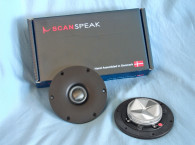
Evidently, the idea of using elliptical-shaped voice coils to control cone and dome modes came from an engineering brain storming session that suggested driving the diaphragm asymmetrically would dramatically reduce concentric cone mode behavior. With an oval-shaped voice coil you get an “infinite” number of Eigen frequencies, but with less contribution to each frequency and overall lower distortion.
Driving the diaphragm symmetrically, you get a finite number of Eigen frequencies with a higher contribution combining at certain frequencies producing cone coloration modes. Photo 1 graphically illustrates the mode differences using a FEA to scanning vibrometer technique to visualize the difference between a cone driven symmetrically with a round voice coil (Photo 1a) versus a cone driven asymmetrically with an elliptical voice coil (Photo 1b). It is my opinion that this is a subjectively very significant development, as proven by some of my design work using Ellipticor drivers in the last several years.
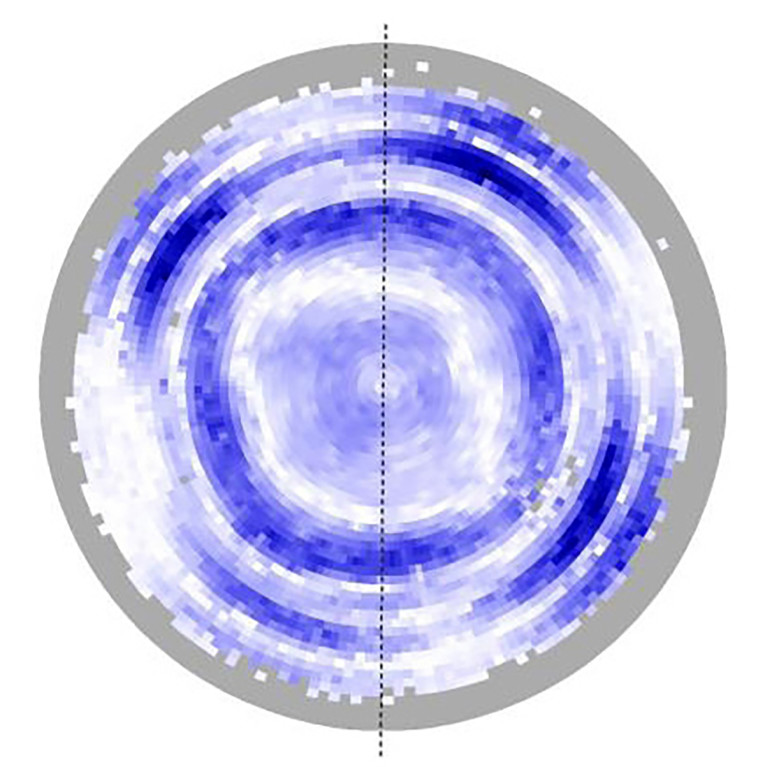
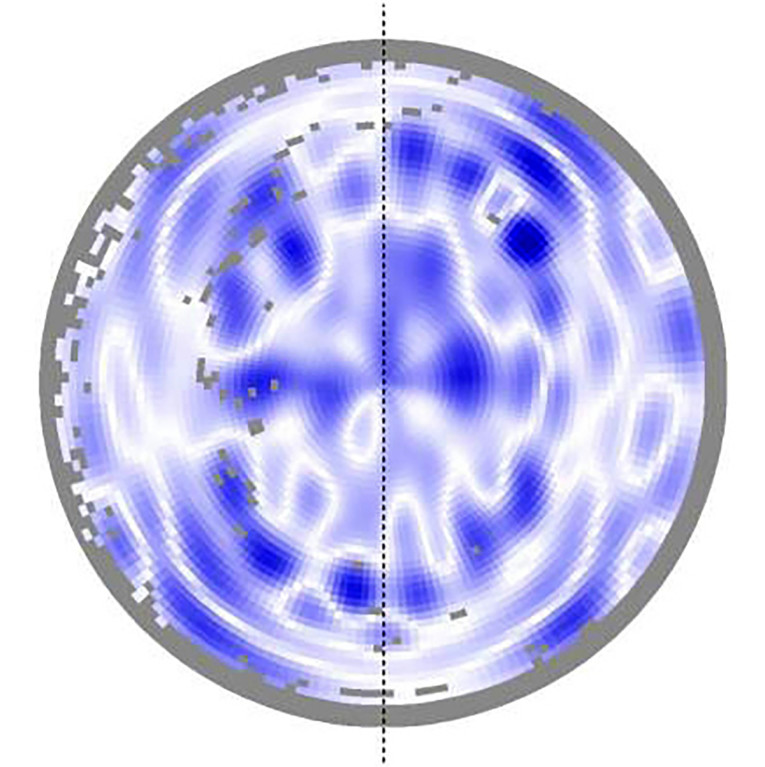
Photo 1: Scan-Speak laser vibrometer scan of a cone driven symmetrically by a conventional round voice coil (a);
Scan-Speak laser vibrometer scan of a cone driven asymmetrically by an oval-shaped Ellipticor voice coil (b)
This month, Scan-Speak sent me the latest iteration from the Ellipticor product line, the 15” 38WE8582T00 woofer (Photos 2-4). As with the 18WE and the 21WE Ellipticor woofers, the 38WE is a seriously feature rich transducer. Starting with the frame, like most of Scan-Speak’s midwoofer/midrange frames, the 38WE frame is a really nicely configured 10-spoke (five double spokes) cast-aluminum frame with narrow 15mm to 25mm wide spokes to minimize reflections back into the cone. The area below the suspended spider mounting shelf is almost completely open (Photo 4), resulting in the very effective cooling of the motor and voice coil.
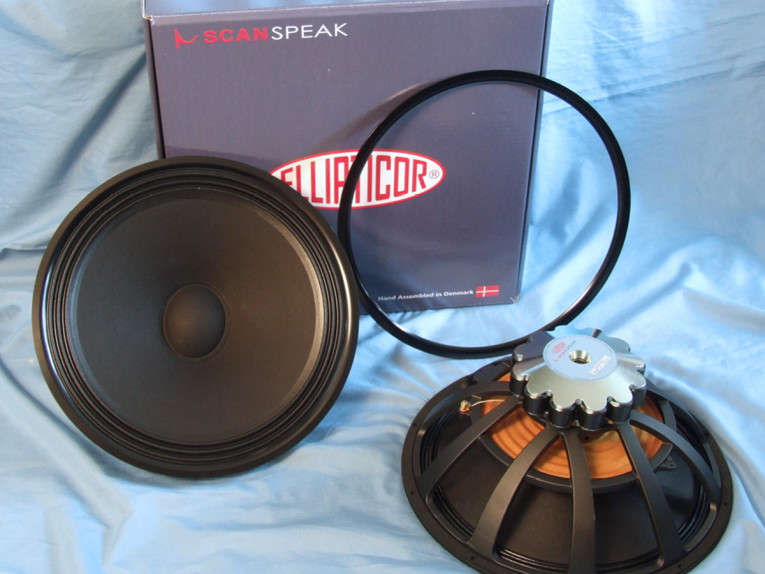

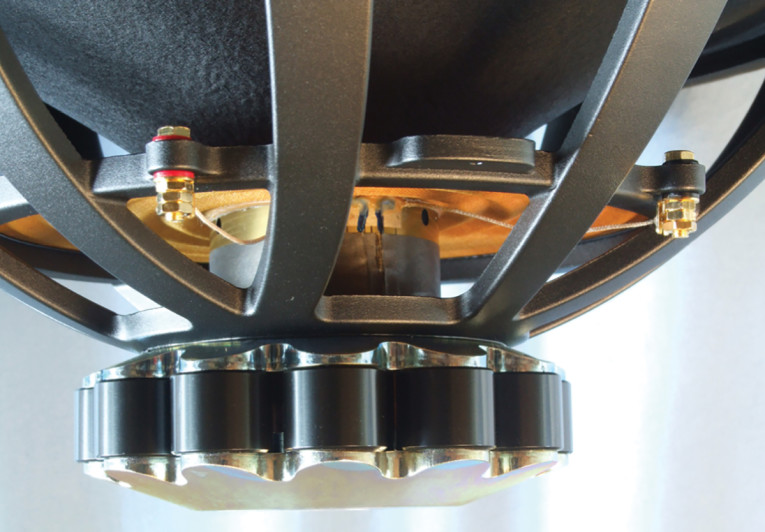
The motor design for the Ellipticor 38WE is similar to the other Ellipticor woofer designs and is also a Symmetrical Drive (SD) AirCirc multi-magnet design utilizing 12 of the 22mm high and 27mm diameter neodymium (neo) slugs with a black emissive coating. It is noteworthy that the neo slugs are spaced about 5mm apart forming 12 open 27mm x 5mm vents, giving the AirCirc motor enormous convection cooling capability.
The AirCirc motor structure also features Scan-Speak’s patented SD motor enhancements and as such incorporates three copper shorting rings (Faraday shields) and a T-shaped pole. FEA designed, the neo magnet motor uses a 84mm x 68mm elliptical 2-layer voice coil wound with round copper wire on a titanium former. Motor parts include polished front and back plates for the neo magnets that includes a 16mm diameter rear vent for additional cooling.
For the cone assembly, Scan-Speak chose a rather stiff curvilinear profile black-coated paper cone with an elliptical 89mm × 70mm convex paper dust cap. Compliance for the 38WE represents a departure from most previous Scan-Speak drivers, and instead of the typical NBR surround, the 38WE has a pleated coated cloth surround, similar to what is found in the majority of pro sound woofers. Given the driver’s 95dB sensitivity, this choice was likely made to lower the Mmd to help achieve the relatively high sensitivity number. A typical pro sound 15” with a coated M-type pleated surround will have a 2.83V/1m sensitivity between 95dB to 99dB, so this is a fair comparison. Remaining compliance comes from an 8.5” diameter flat coated cloth spider (damper).
As with all the Ellipticor line-up, the 38WE has a magnetically attached black anodized aluminum trim ring that can obviously be custom anodized in a variety of colors. Last, the voice coil is terminated to a pair of gold-plated spade lug bolt terminals. In terms of physical appearance, this driver is cosmetically quite attractive.
I began analysis of the 38WE/8582T00 using the LinearX LMS analyzer and Physical Labs Imp Box (identical in function to the LinearX VIBox) to create both voltage and admittance (current) curves with the driver clamped to a rigid test fixture in free-air at 0.3V, 1V, 3V, 6V, 10V, 15V, 20V, and 30V. As with almost all 15” diameter woofers, the driver stayed sufficiently linear out to 30V for LEAP to get a reasonable curve fit.
As has become the protocol for Test Bench testing, I no longer use a single added mass measurement to determine Vas. Instead, I use the actual measured cone assembly mass (Mmd) supplied by the driver’s manufacturer, which was 71.9 grams for the Scan-Speak 15” woofer. Next, I post-processed the 16 550-point stepped sine wave sweeps for each Ellipticor 38WE sample and divided the voltage curves by the current curves (admittance) to derive impedance curves, phase added by the LMS calculation method. I imported them along with the accompanying voltage curves to the LEAP 5 Enclosure Shop software.
Since most Thiele-Small (T-S) data provided by the majority of OEM manufacturers is generated using either the standard model or the LEAP 4 TSL model, I additionally created a LEAP 4 TSL parameter set using the 1V free-air curves. I selected the complete data set, the multiple voltage impedance curves for the LTD model, and the 1V impedance curve for the TSL model (Figure 1) in the transducer derivation menu in LEAP 5. Then, I created the parameters for the computer box simulations. Table 1 compares the LEAP 5 LTD, TSL, and factory published parameters for both of Scan-Speak 38WE samples.
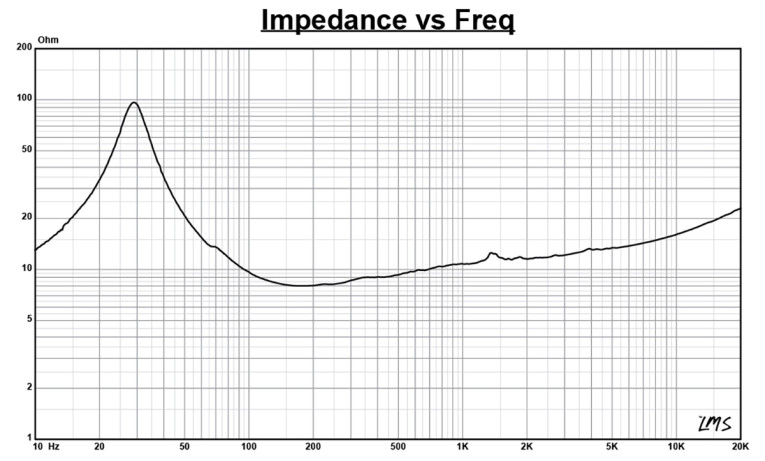
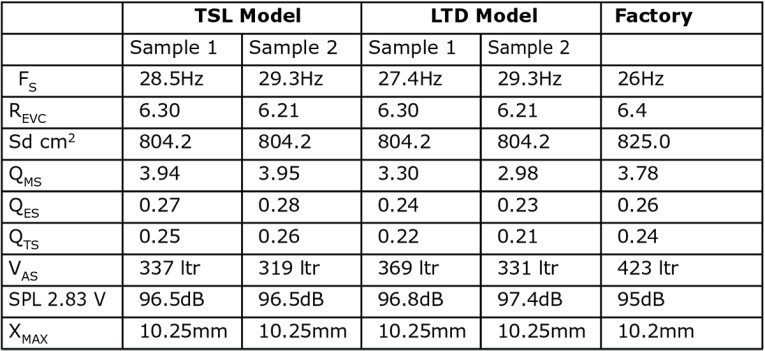
Please note the LinearX LTD model is a more complex transducer model (23 more variables than the TSL model). This extra complexity is why the simulations achieve a significantly more accurate prediction of maximum excursion at high voltage levels. So if you are not familiar with it and wondering why I am using it, the LTD model, though somewhat dated, is still the most advanced transducer model available to the loudspeaker industry.
LEAP parameter calculation results for the Ellipticor 38WE were sufficiently close to the published factory data, with the only significant variation being sensitivity. The sensitivity number I publish is a calculated midband SPL that results from T-S parameter routine, whereas Scan-Speak is using a 2.83V/1m response measurement average.
As usual, I followed my normal protocol and set up computer enclosure simulations using the LEAP LTD parameters for Sample 1. Two computer box simulations were programmed into LEAP 5—one a Qtc=0.7 Butterworth sealed box with a 1.5 ft3 volume with 50% fiberglass damping material; and the second was a vented QB3 enclosure with a 1.9ft3 volume tuned to 46Hz with 15% fiberglass fill material.
Figure 2 displays the results for the Ellipticor 38WE8582 in the vented and sealed enclosures at 2.83V and at a voltage level sufficiently high enough to increase cone excursion to Xmax+15% (11.8mm for the 38WE). This produced a F3 frequency of 78Hz (F6=63Hz) with a Qtc=0.68 for the sealed enclosure and –3dB=70Hz (F6=58Hz) for the vented box. Increasing the voltage input to the simulations until the maximum linear cone excursion was reached resulted in 127dB at 150V for the sealed enclosure simulation and 128dB for the same 150V input level for the vented enclosure. Figure 3 shows the 2.83V group delay curves. Figure 4 shows the 150V excursion curves. I limited the voltage on the vented simulation because the driver started to over excurse below 35Hz, and like most all vented systems, should be band-limited with a high-pass filter.

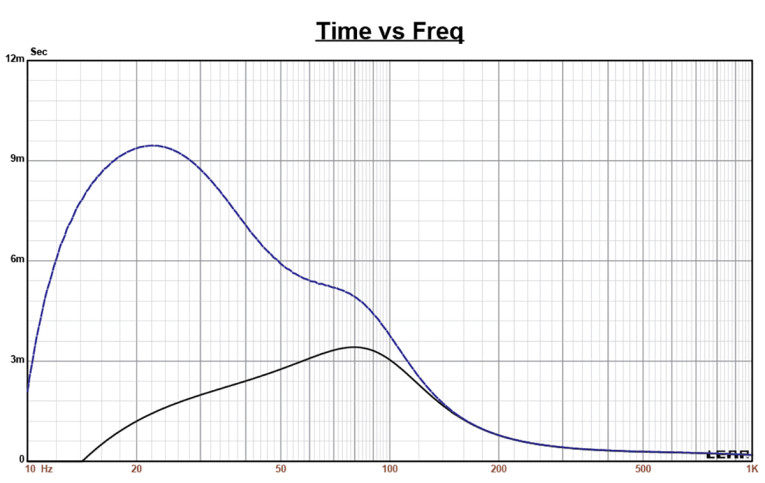

The SPL at maximum excursion number are very high, but this is dependent on the power handling rating input into the LinearX software. I suspect that this driver will be thermal limited before it gets to that high an SPL, but the 38WE also has spectacular convection cooling features in its AirCirc motor, so I would guess that its performance in larger-than-average acoustic spaces will be impressive for a home audio product. I would also note that the 38W is not a subwoofer, but a highly accurate sounding midbass driver that would work well with a large dedicated subwoofer system, even though the driver can be made to play to much lower frequencies in a larger vented box, I think that might be missing the point.
This month, Klippel analysis for the Scan-Speak 15” woofer was performed by Jason Cochrane at Warkwyn, the US distributor for all Klippel products. His analysis on the Klippel KA3 analyzer produced the Bl(X), Kms(X), and Bl and Kms Symmetry Range plots given in Figures 5-8. This data is extremely valuable for transducer engineering, so if you don’t own a Klippel analyzer and would like to have analysis done on a particular project, Redrock Acoustics can provide Klippel analysis of almost any driver for a nominal fee. (Visit www.redrockacoustics.com for more information.)
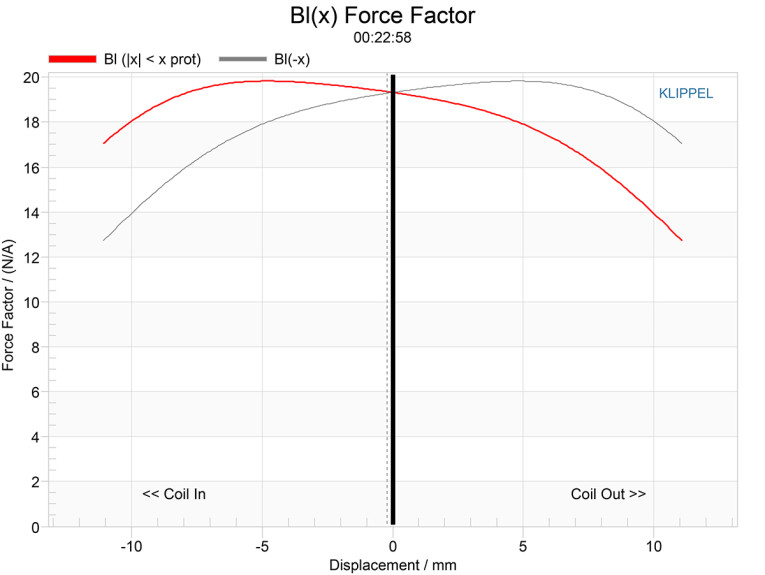
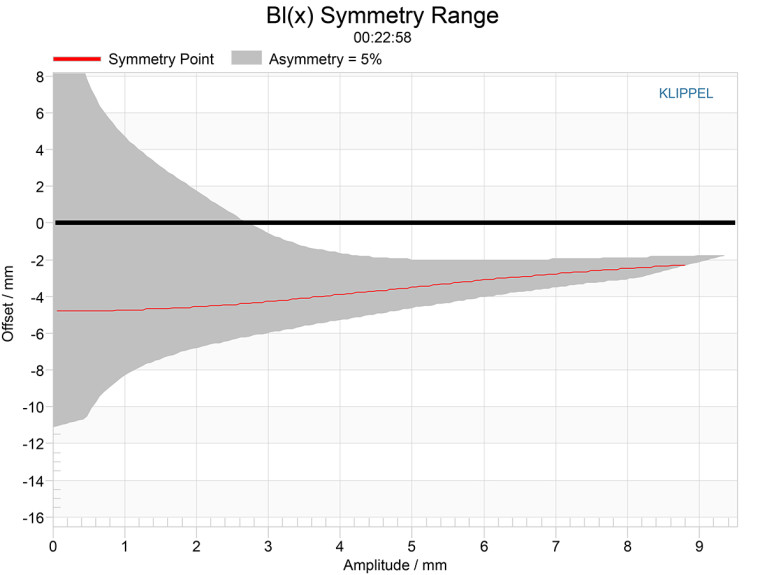
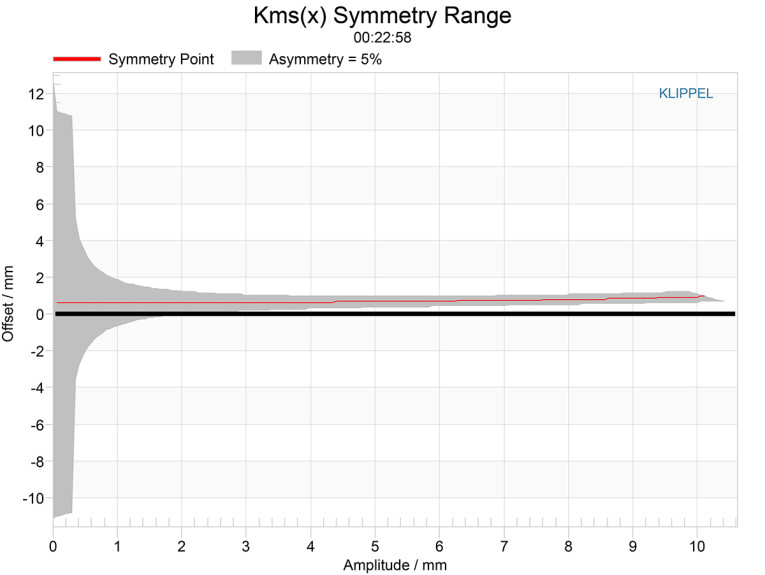
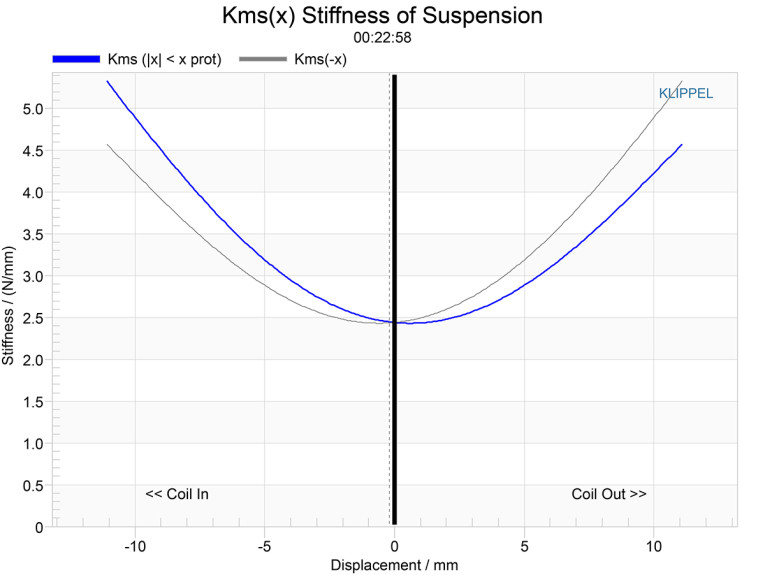
The Bl(X) curve for the 38WE (Figure 5) is mostly symmetrical with a degree of tilt and coil-in offset, however this is fairly broad Bl curve. Looking at the Bl Symmetry plot (Figure 6), from an area of reasonable certainty (the grey overlay) at nearly 0.0mm the coil-in offset is less that 2mm gradually decreasing coil-in offset to the driver Xmax of 10.25mm.
Figure 7 and Figure 8 show the Kms(X) and Kms Symmetry Range curves for the Ellipticor driver, respectively. The Kms(X) curve is definitely symmetrical in both directions with a small degree of coil-out that is only 0.68mm at the 5mm excursion point and stays relatively constant out to the 10.25mm Xmax point and is still less than 1mm (0.95mm).
Displacement limiting numbers calculated by the Klippel analyzer for the Scan-Speak 38WE were XBl @ 82% Bl=7.4mm and for XC @ 75% Cms minimum was 6.1mm, which means that for this Ellipticor, the compliance is the most limiting factor for prescribed distortion level of 10%. If we use a less conservative 20% distortion criteria, which is more appropriate for a large diameter driver like this, with Bl falling to 70% of its maximum value and compliance falling to 50% of its maximum value, the numbers would be XBl=10.4mm and XC=9.8mm, both numbers about the same as physical Xmax of the driver.
Figure 9 gives the inductance curves Le(X) for the 38WE/8582T00. Inductance will typically increase in the rear direction from the zero rest position as the voice coil covers more pole area, which is what you see here. However, because of the effective use of copper shorting rings (Faraday shields) in the Scan-Speak SD AirCirc motor, the inductive swing from Xmax in to Xmax out is a very small 0.13mH, which is very good inductive performance.

With the Klippel testing completed, I mounted the Ellipticor 38WE woofer in an enclosure, which had a 18” × 16” baffle (supplied by David Nelson of Portland Audio Labs), and was filled with damping material (foam). The device under test (DUT) was then measured on- and off-axis from 300Hz to 20kHz frequency response at 2.00V/0.5m, normalized to 2.83V/1m using the Loudsoft FINE R+D FFT analyzer and the GRAS 46BE 1/4” microphone (both the analyzer and the mic were provided to Voice Coil by the manufacturers).
Figure 10 gives the 38WE’s on-axis response, indicating a smoothly rising response to about 1.2kHz followed by a broad 5dB peak center on about 1.7kHz where it begins is low-pass roll-off. Figure 11 displays the on- and off-axis frequency response at 0°, 15°, 30°, and 45°. The -3dB frequency at 30° off-axis relative to the on-axis SPL is about 1kHz, suggesting a crossover between 1kHz should be possible, but I would more likely chose a cross point below 400Hz to maximize the system DI curve. The normalized version of Figure 11 is shown in Figure 12, with the CLIO polar plot (done in 10° increments) displayed in Figure 13. And finally, Figure 14 gives the two-sample SPL comparisons for the 15” Ellipticor driver, showing a close match (less than 0.5dB variation) throughout the operating range.

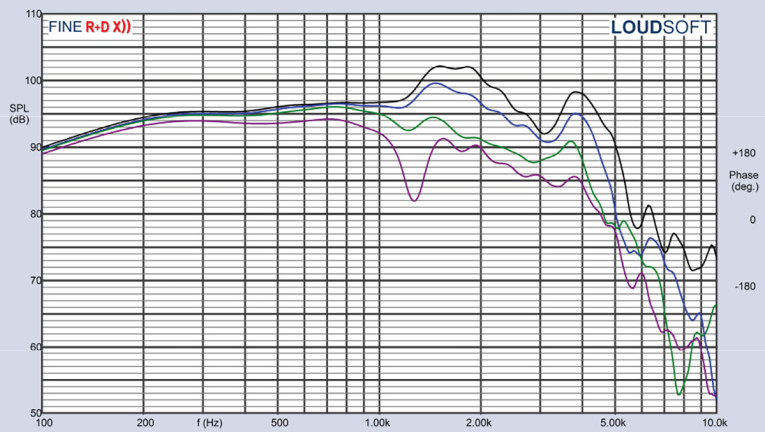
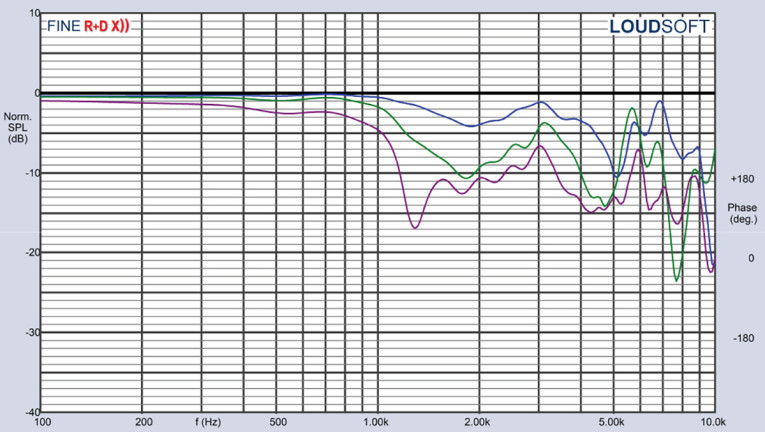

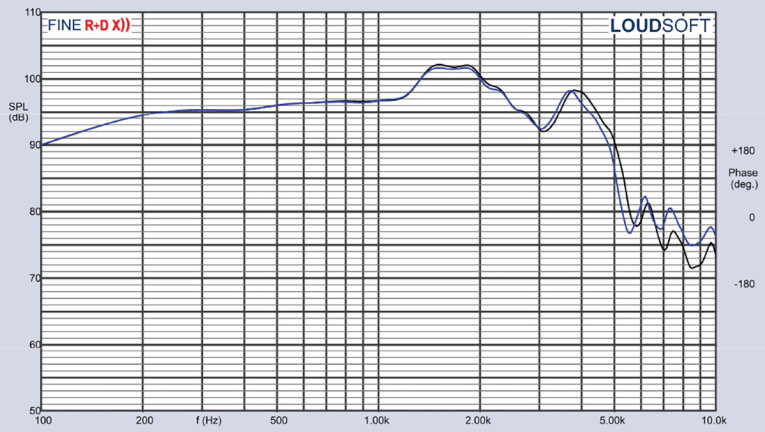
For the remaining series of tests, I set up the Listen, Inc. SoundCheck 18 software, AudioConnext analyzer, and 1/4” SCM microphone (courtesy of Listen, Inc.) to measure distortion and generate time-frequency plots. For the distortion measurement, I mounted the 15” woofer rigidly in free-air, and set the SPL to 94dB at 1m (2.21V), using the pink noise generator and SLM built into the SoundCheck 18 software. I then measured the distortion with the Listen microphone placed 10cm from the dust cap. This produced the distortion curves shown in Figure 15. Scan-Speak claims very low distortion for the 38WE, and as can be seen, this is indeed the case with third-order harmonic distortion extremely low.
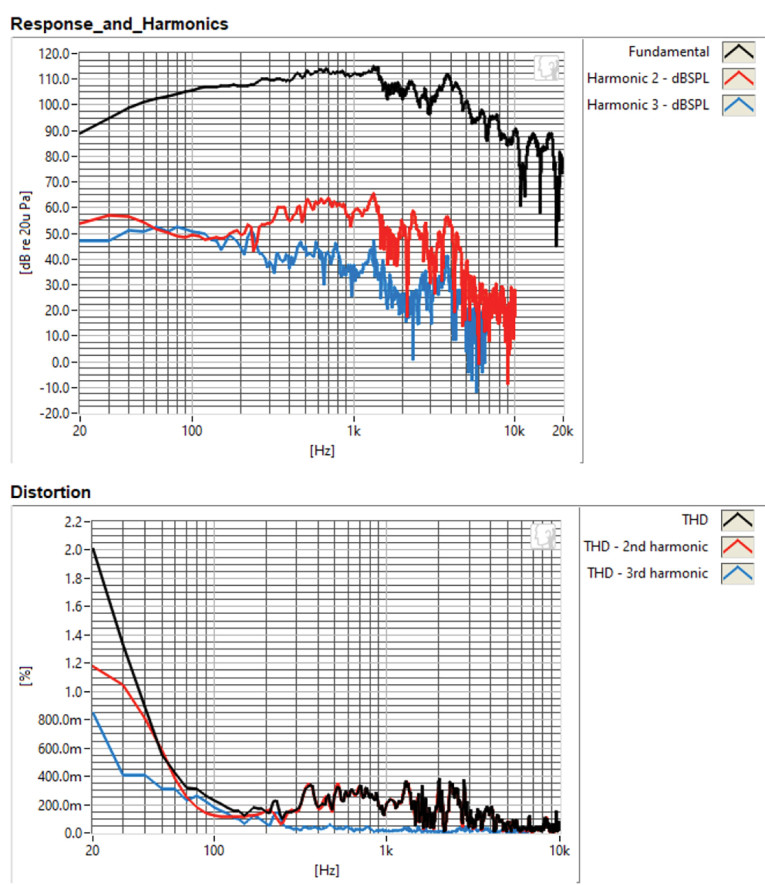
For the last test, I used SoundCheck 18 to get a 2.83V/1m 38WE impulse response and imported that data into Listen’s SoundMap Time/Frequency software. Figure 16 shows the resulting CSD waterfall plot. Figure 17 shows the Wigner-Ville plot (chosen for its better low-frequency performance).


The test results for this unique oval-shaped voice coil 15” transducer indicate very good performance. While I have as yet no experience designing the 38WE into a system, I have managed to design a product using both the Ellipticor 18WE and the D3404, and in my humble opinion, the results were extremely musical sounding. For more information about these and other high-end Scan-Speak transducers, visit www.scan-speak.dk. VC
This article was originally published in Voice Coil, July 2022







